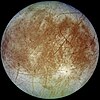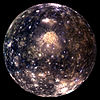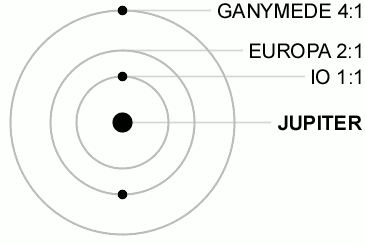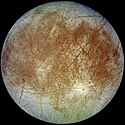Galileuszowe księżyce Jowisza

Galileuszowe księżyce Jowisza – cztery największe księżyce Jowisza odkryte przez Galileusza w styczniu 1610 roku — Io, Europa, Kallisto i Ganimedes. Obserwacje, które dowiodły istnienia pierwszych obiektów orbitujących inne ciało niebieskie Układu Słonecznego niż Ziemia. Galileusz prowadził je przy pomocy skonstruowanej przez siebie lunety. Uważa się, że księżyce te zaobserwował niezależnie, w tym samym czasie, niemiecki astronom Simon Marius.
Nazwy
Księżyce noszą nazwy (w kolejności od planety): Io, Europa, Ganimedes i Kallisto. Zostały one zaproponowane przez Mariusa, Galileusz nazywał je „gwiazdami medycejskimi” (Sidera Medicea), na cześć rodu Medyceuszy. Dziś używane nazwy pochodzą od imion kochanek (i kochanka) Zeusa, greckiego odpowiednika boga Jupitera, czyli Jowisza: Io, Europy, Ganimedesa i Kallisto.
Na podstawie swoich obserwacji Galileusz uznał, że księżyce krążą wokół Jowisza. Odkrycie to wspierało heliocentryczną teorię Kopernika, pokazując że nie wszystkie ciała niebieskie krążą wokół Ziemi.
Rezonans orbitalny
Księżyce galileuszowe pozostają wobec siebie w rezonansie orbitalnym (4:2:1). Na cztery obiegi Io wokół Jowisza przypadają dwa obiegi Europy i jeden Ganimedesa. Dodatkowo Kallisto znajduje się w rezonansie (3:7) z Ganimedesem. Efektem tego rezonansu jest wymuszona eliptyczność orbity i deformacje pływowe generujące energię cieplną wewnątrz satelitów.
Parametry fizyczne księżyców galileuszowych
W kolejności rosnącej odległości od Jowisza, zdjęcia nie są w skali.
| Numer | Nazwa | Zdjęcie | Jasność[1] | Średnica[1] [km] | Półoś wielka[1] [tys. km] | Okres obiegu[1] [dni] | Mimośród orbity | Nachylenie orbity | Rok odkrycia[1] |
|---|---|---|---|---|---|---|---|---|---|
| I | Io |  | 5,0 | 3643 | 421,8 | 1,77 | 0,0041 | 0,036 | 1610 |
| II | Europa |  | 5,3 | 3122 | 671,1 | 3,55 | 0,0094 | 0,467 | 1610 |
| III | Ganimedes |  | 4,6 | 5262 | 1 070,4 | 7,16 | 0,0011 | 0,172 | 1610 |
| IV | Kallisto |  | 5,7 | 4821 | 1 882,7 | 16,69 | 0,0074 | 0,307 | 1610 |
Prawie do końca XIX wieku uważano, że Jowisz ma tylko cztery księżyce. Dopiero w 1892 amerykański astronom Edward Emerson Barnard odkrył piąty księżyc – Amalteę, krążącą bliżej Jowisza niż księżyce galileuszowe. W grudniu 2018 znanych było 79 satelitów planety, w większości bardzo małych[2].
Zobacz też
- księżyce Jowisza – lista satelitów planety
- galileoskop
Przypisy
- ↑ a b c d e Scott Sheppard, Moons of Jupiter, Carnegie Science [dostęp 2020-03-14] (ang.).
- ↑ How Many Solar System Bodies (ang.). [dostęp 2018-12-15].
Linki zewnętrzne
- Overview: Jupiter Moons (ang.). W: Solar System Exploration [on-line]. NASA. [dostęp 2018-12-15].
| ||||||||||||||||||||||||||
| ||||||||||||
Media użyte na tej stronie
Animation of the 1:2:4 Laplace resonance between Io, Europa, and Ganymede. The labels indicate the ratios of orbital periods: Europa's is twice Io's, and Ganymede's is four times Io's.
Warning: do not downsize the image below its original size of 365 × 245 when used in a Wikipedia article, as the animation won't move then (at least not for all users).
Original Caption Released with Image: This processed color image of Jupiter was produced in 1990 by the U.S. Geological Survey from a Voyager image captured in 1979. The colors have been enhanced to bring out detail. Zones of light-colored, ascending clouds alternate with bands of dark, descending clouds. The clouds travel around the planet in alternating eastward and westward belts at speeds of up to 540 kilometers per hour. Tremendous storms as big as Earthly continents surge around the planet. The Great Red Spot (oval shape toward the lower-left) is an enormous anticyclonic storm that drifts along its belt, eventually circling the entire planet.
Sztuczna kompilacja obrazów księżyców galileuszowych, pokazująca porównanie ich rozmiarów z rozmiarami Jowisza (widoczna Wielka Czerwona Plama). Od góry: Io, Europa, Ganimedes i Callisto.
Photo of Ganymede, obtained by the Galileo spacecraft, with enhanced contrast. This is a crop of Image:The Galilean satellites (the four largest moons of Jupiter).tif (PIA01299)
Here is the description from JPL's web entry for PIA00716 (http://photojournal.jpl.nasa.gov/catalog/PIA00716):
Natural color view of Ganymede from the Galileo spacecraft during its first encounter with the satellite. North is to the top of the picture and the sun illuminates the surface from the right. The dark areas are the older, more heavily cratered regions and the light areas are younger, tectonically deformed regions. The brownish-gray color is due to mixtures of rocky materials and ice. Bright spots are geologically recent impact craters and their ejecta. The finest details that can be discerned in this picture are about 13.4 kilometers across. The images which combine for this color image were taken beginning at Universal Time 8:46:04 UT on June 26, 1996.
The Jet Propulsion Laboratory, Pasadena, CA manages the mission for NASA's Office of Space Science, Washington, DC. This image and other images and data received from Galileo are posted on the World Wide Web, on the Galileo mission home page at URL http://galileo.jpl.nasa.gov. Background information and educational context for the images can be found at http://www.jpl.nasa.gov/galileo/sepo.This image shows a view of the trailing hemisphere of Jupiter's ice-covered satellite, Europa, in approximate natural color. Long, dark lines are fractures in the crust, some of which are more than 3,000 kilometers (1,850 miles) long. The bright feature containing a central dark spot in the lower third of the image is a young impact crater some 50 kilometers (31 miles) in diameter. This crater has been provisionally named "Pwyll" for the Celtic god of the underworld. Europa is about 3,160 kilometers (1,950 miles) in diameter, or about the size of Earth's moon. This image was taken on September 7, 1996, at a range of 677,000 kilometers (417,900 miles) by the solid state imaging television camera onboard the Galileo spacecraft during its second orbit around Jupiter. The image was processed by Deutsche Forschungsanstalt fuer Luftund Raumfahrt e.V., Berlin, Germany.








